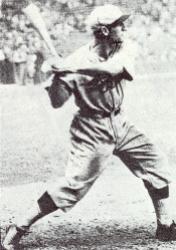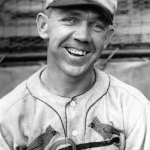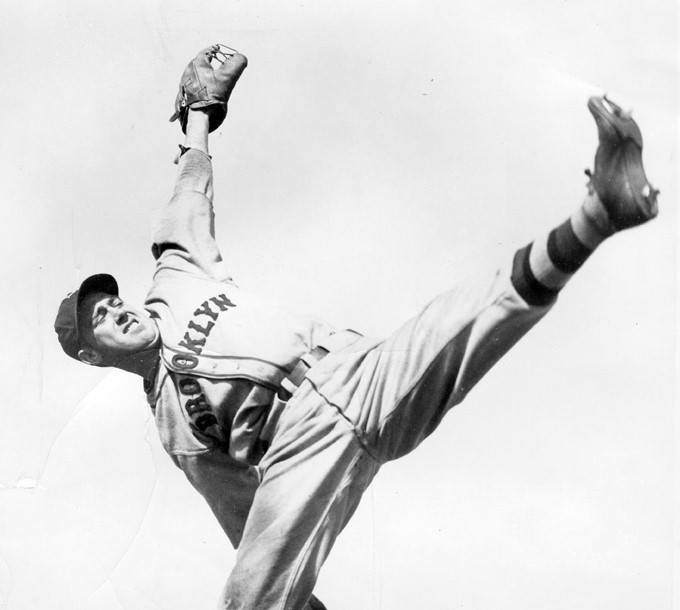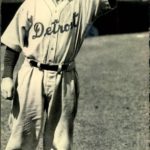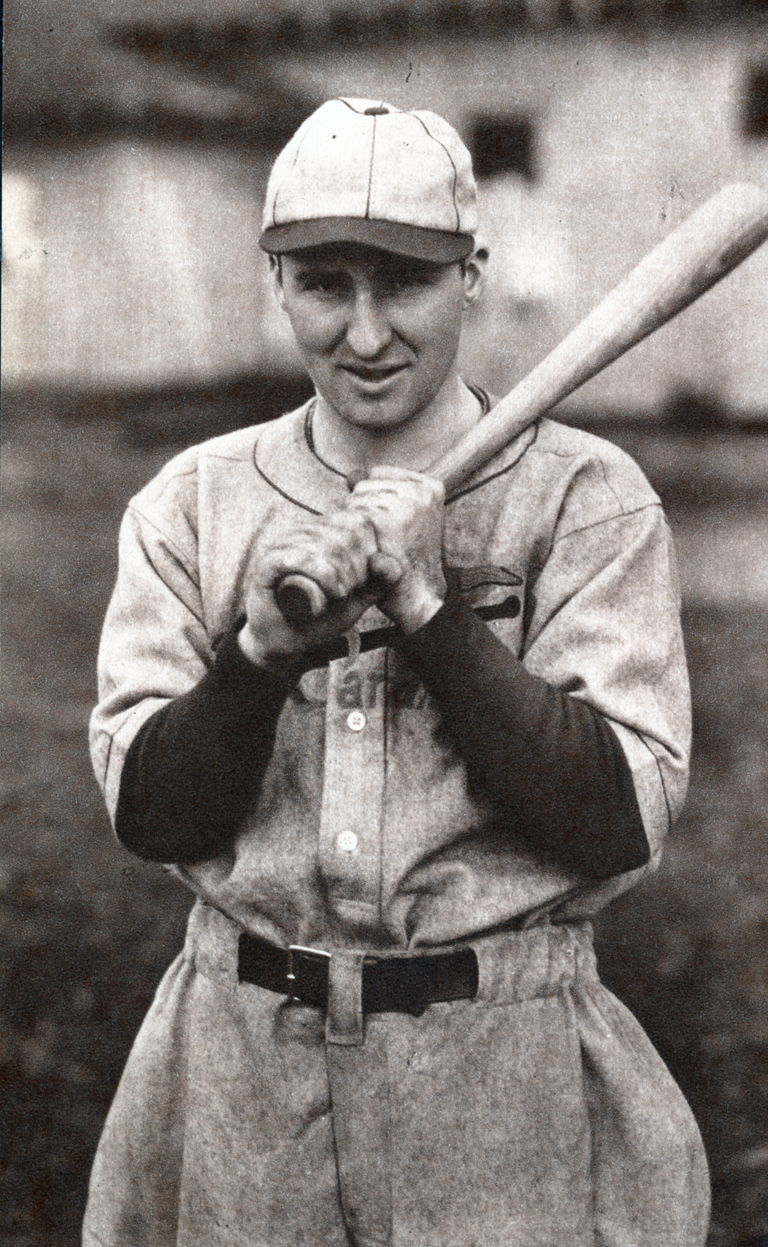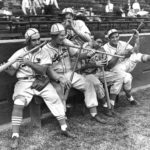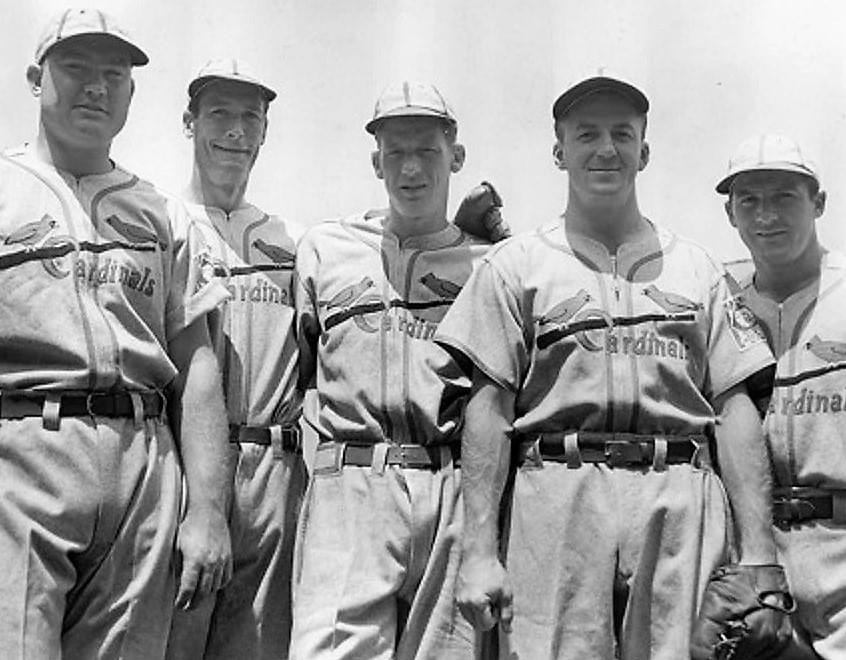Pepper Martin Stats & Facts
Pepper Martin
Positions: Outfielder and Third Baseman
Bats: Right • Throws: Right
5-8, 170lb (173cm, 77kg)
Born: February 29, 1904 in Temple, OK
Died: March 5, 1965 in McAlester, OK
Buried: Quinton Cemetery, Quinton, OK
Debut: April 16, 1928 (5,844th in MLB history)
vs. CHC 1 AB, 1 H, 0 HR, 0 RBI, 0 SB
Last Game: October 1, 1944
vs. NYG 0 AB, 0 H, 0 HR, 0 RBI, 0 SB
Rookie Status: Exceeded rookie limits during 1931 season
Full Name: Johnny Leonard Roosevelt Martin
Nicknames: The Wild Horse Of The Osage
View Player Bio from the SABR BioProject
Nine Players Who Debuted in 1928
Al Lopez
Bill Dickey
Chuck Klein
Rollie Hemsley
Pepper Martin
Mel Harder
Carl Hubbell
George Earnshaw
Clint Brown
All-Time Teammate Team
Coming Soon
Notable Events and Chronology for Pepper Martin Career
Martin, labeled “The Wild Horse of the Osage” by a Rochester sportswriter for his aggressive play, was the personification of the Cardinals’ Gashouse Gang. He played every facet of the game with passion. His bellyflop slides helped him to lead the NL in stolen bases and score more than 120 runs in each of three seasons. He dashed for every batted ball as if it were the seventh game of the World Series. In lopsided games, he would reportedly throw at batters who bunted instead of throwing them out at first. He got along well with manager Frankie Frisch, although his horseplay could exasperate the skipper.
In the 1931 World Series, Martin batted .500, with five extra-base hits and five stolen bases. His career World Series batting average of .418 was the highest among players with 50 or more at-bats until David Ortiz and Pablo Sandoval passed him in 2013 and 2014.
Baseball career
Early career
Born in Temple, Oklahoma, Martin moved to Oklahoma City with his parents at the age of six where he grew up playing baseball. He began his professional baseball career at the age of 19 when he signed to play as a shortstop in the Oklahoma State League for a team in Guthrie, Oklahoma. When the league folded in 1924, his contract was sold to the Greenville Hunters of the East Texas League. In 1925, he posted a .340 batting average in 98 games for the Hunters. He continued to post batting averages above the .300 mark and in 1927, he was signed by the St. Louis Cardinals to play for their affiliate, the Houston Buffaloes. After hitting for a .306 average in 147 games with Houston, he earned a promotion to the major leagues.
Martin made his major league debut with the Cardinals on April 16, 1928 at the age of 24. He posted a .308 batting average in 39 games as a utility player, as the Cardinals won the National League pennant. Martin made one appearance as a pinch runner in the 1928 World Series, as the Cardinals lost in four straight games to the New York Yankees.
Martin was sent back to the Houston Buffaloes in January 1929. His batting average dropped to .298 with Houston. However, the following season with the Rochester Red Wings, his offensive statistics improved with 20 home runs, a .363 batting average and a .631 slugging percentage, helping the Red Wings win the 1930 International League title. The Red Wings then defeated the Louisville Colonels of the American Association to win the Junior World Series.
Martin’s performance earned him a return to the major leagues with the Cardinals in 1931. When veteran center fielder Taylor Douthit went into a hitting slump, Martin replaced him and played well enough that Cardinals’ president, Branch Rickey, would trade Douthit to the Cincinnati Reds in June. Martin impressed observers with his hustle in the outfield as well as on the base paths where he often slid into bases head-first. He ended the year with a .300 batting average along with 7 home runs and 75 runs batted in to help the Cardinals clinch the 1931 National League pennant by 13 games over the New York Giants.
World Series star
The 1931 World Series was a rematch of the previous year’s participants, pitting the Cardinals against the Philadelphia Athletics. Led by Connie Mack, the Athletics had won the previous two World Series and were heavily-favored to win for a third consecutive year. They featured a lineup that included five future National Baseball Hall of Fame members in Mickey Cochrane, Jimmie Foxx, Lefty Grove, Waite Hoyt and Al Simmons.
In Game 1 held at Sportsman’s Park in St. Louis, Martin had three hits, including a double, a stolen base and drove in one run in a 6 to 2 loss to the ace of the Athletics staff, 31-game winner Lefty Grove. Martin proved to be the difference in Game 2 in what was otherwise a tight pitching duel between Bill Hallahan of the Cardinals and George Earnshaw for the Athletics. He scored the first run of the game in the second inning by stretching a single into a double when the ball was bobbled in the outfield, stealing third base, and then scoring on a sacrifice fly. Martin added another run in the seventh inning when he hit a single, stole second base, took third base on a fielder’s choice, and then scored on a squeeze bunt. Those would be the only runs of the game as Hallahan pitched a three-hit shutout to even the series at one win apiece.
The series then moved to Shibe Park in Philadelphia for Game 3, where Martin had two hits, including a double and scored twice in a 5-2 Cardinals’ victory over Grove. In Game 4, he produced the only two hits by the Cardinals as they lost to Earnshaw 3 to 0. Martin almost single-handedly provided the offense for the Cardinals in Game 5, driving home four runs with 2 singles, a home run and a sacrifice fly, as the Cardinals triumphed 5 to 1.
Although Martin was held hitless in the final two games of the series, he made an impressive catch to squelch an Athletics two-run rally in the ninth inning of Game 7 to end the game and clinch the world championship for the Cardinals. He set a World Series record with 12 hits including 4 doubles, 1 home run, 5 stolen bases and 5 runs batted in. Martin’s .500 series batting average may have made the difference in the series outcome, as without him, the Cardinals batted for just a .205 team batting average. During the series, Martin was asked how he had learned to run so fast; he replied, “I grew up in Oklahoma, and once you start runnin’ out there there ain’t nothin’ to stop you”. Longtime major league manager, John McGraw, described Martin’s performance as “the greatest individual performance in the history of the World Series.” In December, Martin was selected as male athlete of the year by the Associated Press.
The Gashouse Gang
Martin, along with Cardinals teammates such as Leo Durocher, Dizzy Dean and Joe Medwick among others, became known as the Gashouse Gang due to their boisterous activities on and off the field. He played the guitar in a hillbilly band composed of Cardinals players named The Mudcat Band.
He experienced an injury-plagued season in 1932, missing several weeks when he dislocated his shoulder in April and missed a month and a half when he broke a finger in July while sliding into home plate. In August, Cardinals manager Gabby Street converted Martin into a third baseman in an attempt to fill the gap left by the injured Sparky Adams. Martin was not a naturally gifted third baseman, often fielding balls after having stopped them with his chest. He ended the season with a .238 batting average with 4 home runs and 34 runs batted in as the Cardinals fell to seventh place in the National League.
Martin rebounded from his injuries in 1933, and was leading the league in hitting with a .363 batting average in the middle of June, earning him a starting role as the third baseman for the National League team in the inaugural Major League Baseball All-Star Game held on July 6, 1933. Now hitting as the Cardinals’ leadoff hitter, he finished the season ranked sixth in the league with a career-high .316 average and led the league with 122 runs scored and 26 stolen bases. Martin ranked tenth in the league with a .456 slugging percentage, and he had a career-high .387 on base percentage along with 36 doubles, 12 triples and 8 home runs as the Cardinals improved to a fifth place finish. He came in fifth place in the voting results for the 1933 National League Most Valuable Player Award.
Martin’s batting average dropped to .289 in 1934, but he once again led the league in stolen bases as the Cardinals rallied from seven games behind the New York Giants in early September to win the National League pennant on the last day of the season. He made an appearance as a relief pitcher on August 19, allowing one hit in two innings pitched. In a memorable 1934 World Series against the Detroit Tigers, the Cardinals were down 3 games to 2, before rebounding to win the final two games. The series was highlighted by several rough plays on the base paths that culminated in Game 7, when Joe Medwick made a rough slide into Tigers’ third baseman Marv Owen. The following inning, outraged Detroit fans pelted Medwick with debris when he assumed his defensive position in the outfield. The disturbance wasn’t quelled until the umpires appealed to Baseball Commissioner Kenesaw Mountain Landis, who had Medwick removed from the game. Martin ended the series with 11 hits for a .355 average, stole 2 bases and scored 8 runs in the series. He experienced difficulties in the field, committing 3 errors in Game 4 and setting a World Series record with 4 errors overall.
While in a St. Louis hospital in December 1934, for a minor operation on his left arm, Martin insisted that he be entertained by a cowboy musical group that he had hired. He created such a disturbance among the other patients that the hospital staff moved him to an isolated wing.
Although Martin had a good year offensively in 1935, he continued to struggle defensively at third base. In the midst of a tight pennant race in July, he committed three costly errors in a loss to the New York Giants, and ended the year with 30 errors. He was hitting for a .333 average by mid-season to earn the starting third baseman’s position in the 1935 All-Star Game. For the season, he hit for a .299 average with 9 home runs and 54 runs batted in.
In October, Martin underwent surgery again, this time on his right arm. In January 1936, Branch Rickey asked Martin to curtail his extra-curricular activities. Already well known as a hunting and fishing enthusiast, Martin had taken up the hobby of midget car racing and was also playing in football and basketball games during the winter months. He also became the vice-president and general manager of an Oklahoma City ice hockey team.
Martin moved back to the outfield, playing as the Cardinals’ right fielder in 1936 as the Cardinals battled the New York Giants for the National League title before settling for second place. He responded with a good year offensively, hitting for a .309 average with career-highs in home runs and in runs batted in (76). Martin also led the National League in stolen bases with 23.
Although he continued to hit well, by 1937, Martin was relegated to a part-time role, as his spirited, headlong style of play took its toll on his body. At the beginning of the 1939 season, he was named as the Cardinals’ team captain, taking the job from Leo Durocher who had been traded to the Brooklyn Dodgers. He experienced a resurgence, leading the team with a .340 batting average in June before a sprained wrist put him out of action for two weeks. He ended the season with a .306 batting average in 88 games, helping the Cardinals to finish second in the National League. Martin hit for a respectable .316 average in 1940 before the Cardinals named him as the player-manager of the Sacramento Solons of the Pacific Coast League in October.
Martin led Sacramento to a second place finish in 1941 before leading them to their first Pacific Coast League championship in 38 years in 1942. He then became a player-manager for the Rochester Red Wings in 1943. When professional baseball experienced a shortage of players during World War II, Martin returned to the major leagues in 1944 with the Cardinals at the age of 40. In 40 games with the Cardinals, he posted a .279 batting average and an impressive .386 on base percentage to help the Cardinals clinch the 1944 National League pennant. Martin didn’t appear in the 1944 World Series, playing his final major league game on October 1, 1944.
Career statistics
In a thirteen-year major league career, Martin played in 1,189 games, accumulating 1,227 hits in 4,117 at bats for a .298 career batting average along with a .443 slugging percentage, 59 home runs, 501 runs batted in, 146 stolen bases and an on base percentage of .358. He retired with a .973 career fielding percentage in 613 games as an outfielder and a .927 fielding percentage in 429 games as a third baseman. A four-time All-Star, Martin’s World Series career batting average of .418 is still a series record, and he is tied for tenth with 7 World Series stolen bases. He led the National League three times in stolen bases and once in runs scored. On May 5, 1933, Martin hit for the cycle in a game against the Philadelphia Phillies at the Baker Bowl.
Managing career
After the end of his major league career, Martin returned to the minor leagues, serving as a player-manager with the San Diego Padres of the Pacific Coast League in 1945 and 1946 before becoming the player-manager for the Greenville Spinners of the South Atlantic League in 1947. His fiery, competitive spirit was still evident in July 1945 when it was reported that he had punched one of his players for not performing to his standards. While managing the Miami Sun Sox of the Florida International League in 1949, he was fined and suspended for the remainder of the season for choking an umpire. In August 1951, he made news again when he was arrested after a Sun Sox game when he went into the stands to punch a spectator in Lakeland, Florida.
After being released by the Sun Sox, Martin was hired to manage the Miami Beach Flamingos of the Florida International League in 1952. Despite leading them to a 103-49 record, the Flamigos finished the season one game behind his former team, the Sun Sox. In 1953, he became the manager of the Fort Lauderdale Lions and led them to the Florida International League title. After spending the 1954 season as the manager for the Portsmouth Merrimacs, Martin was named as a coach for the Chicago Cubs in September 1955. When the Cubs finished in last place in the 1956 season, manager Stan Hack was fired and the new Cubs manager, Bob Scheffing, asked for Martin’s resignation along with the rest of the coaching staff. Martin returned to the minor leagues once again where he became a player-coach for the Tulsa Oilers, playing his final game at the age of 54. He took his final field assignment as the manager of the Miami Marlins in 1959.
Later life
Before his death, he served briefly as the athletic director of the Oklahoma State Penitentiary at McAlester, Oklahoma. Martin died on March 5, 1965 after suffering a heart attack. His wife, Ruby, survived him by over four decades, passing away just short of her 100th birthday in 2009. Martin was inducted into the Oklahoma Sports Hall of Fame in 1992.
@ET-DC@eyJkeW5hbWljIjp0cnVlLCJjb250ZW50IjoicG9zdF90YWdzIiwic2V0dGluZ3MiOnsiYmVmb3JlIjoiTGVhcm4gTW9yZSBhYm91dCB0aGUgdGVhbXMsIHBsYXllcnMsIGJhbGwgcGFya3MgYW5kIGV2ZW50cyB0aGF0IGhhcHBlbmVkIG9uIHRoaXMgZGF0ZSBpbiBoaXN0b3J5IC0gLSAtIC0gLSAtIC0gIiwiYWZ0ZXIiOiIiLCJsaW5rX3RvX3Rlcm1fcGFnZSI6Im9uIiwic2VwYXJhdG9yIjoiIHwgIiwiY2F0ZWdvcnlfdHlwZSI6InBvc3RfdGFnIn19@
Factoids, Quotes, Milestones and Odd Facts
Coming soon
Other Resources & Links
Coming Soon
If you would like to add a link or add information for player pages, please contact us here.

